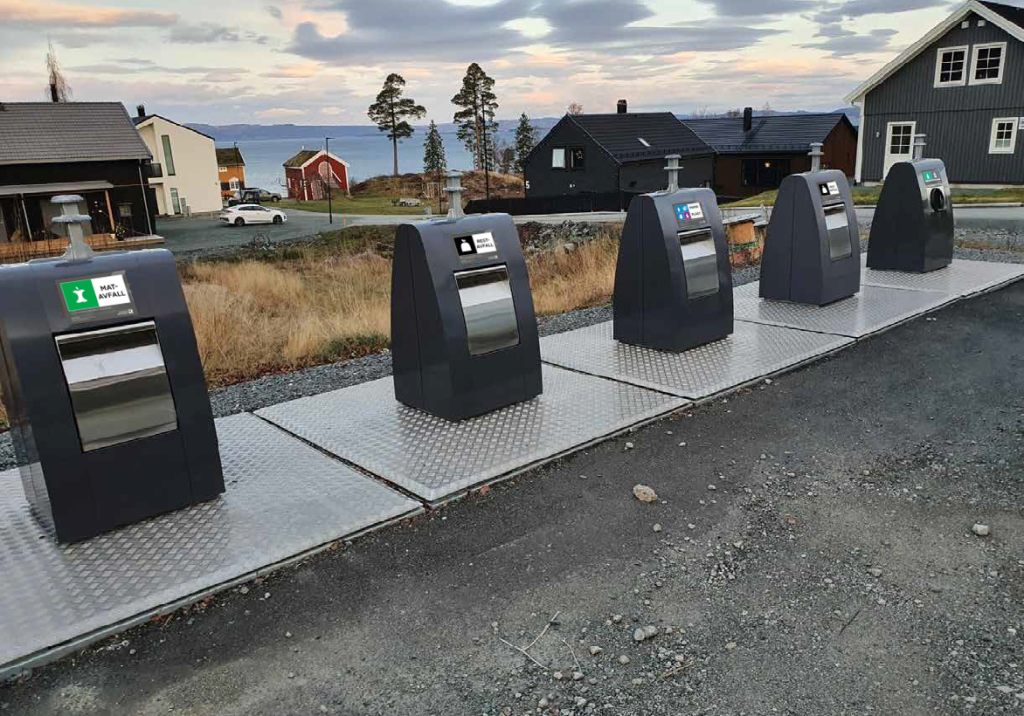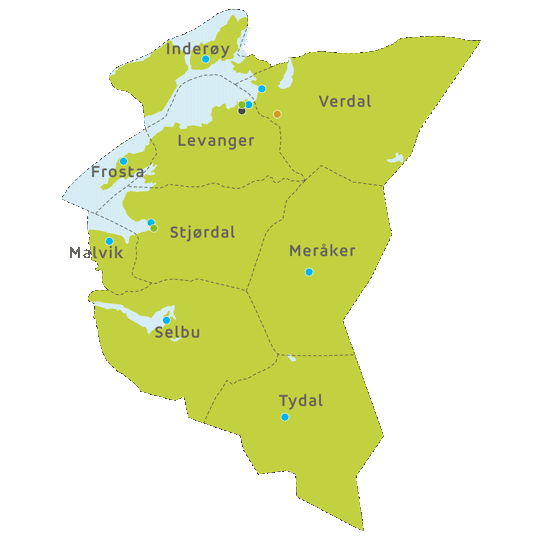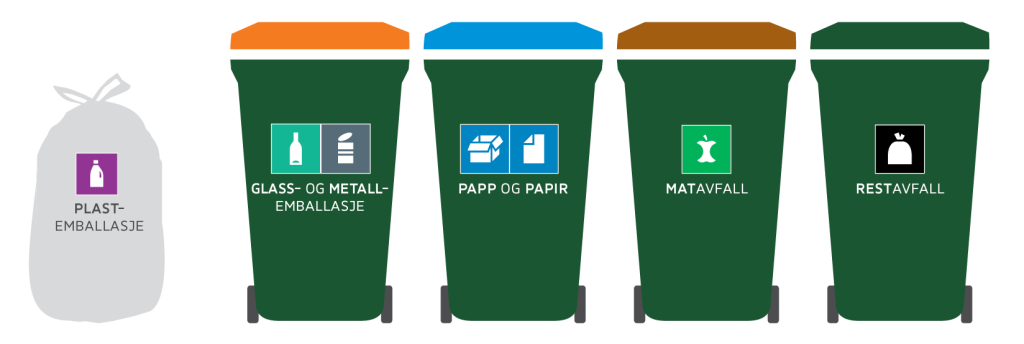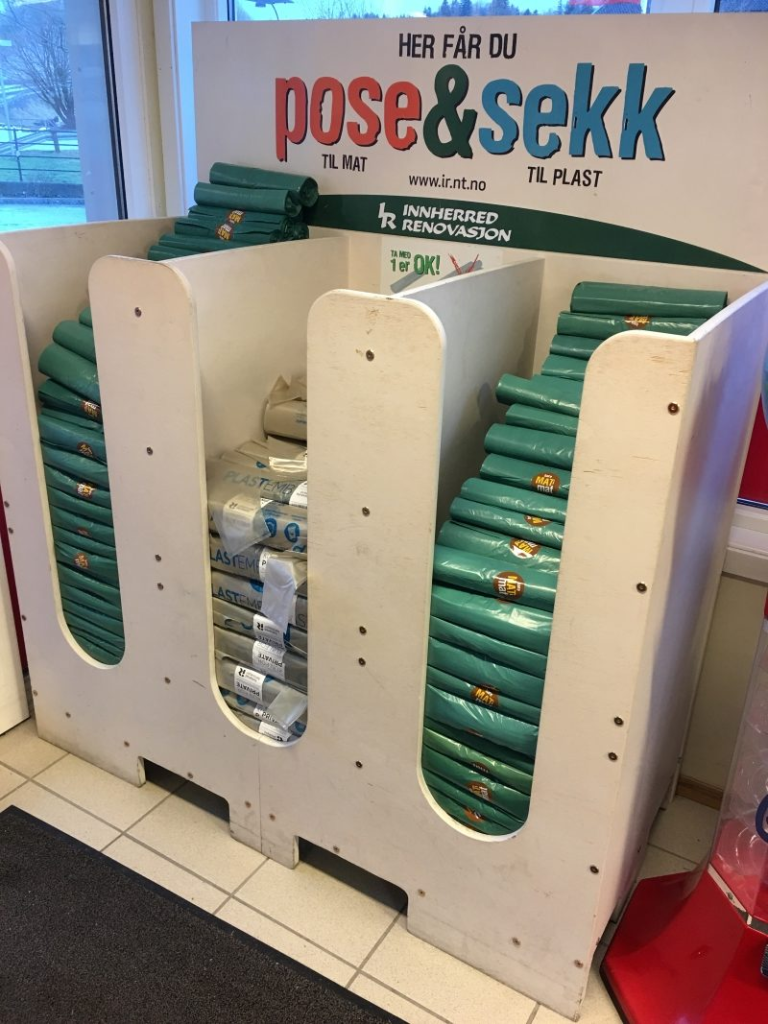
I last wrote about Innherred Renovasjon (IR), just after the Utøy Recycling Station opened on 2018-09-18. This station serves all of Inderøy, and is located 7.3 km east-north-east of Cliff Cottage, on Hwy 755, our usual road to Straumen, the municipal centre, 12.3 km away.
This post looks at what happens to the various categories of waste, that is either picked up by truck, or received at a recycling station. It was started on 2018-10-21 at 14:43 to give an overview of regional recycling. For over four years this post has been gestating. This is a polite way of saying that it has been ignored most of this time, apart from short periodic bouts of guilt, encouraging sufficient enthusiasm for me to look at the post, before procrastination, once again, takes the upper hand.
Owned by and operating in nine of Trøndelag County’s 38 municipalities, IR, describes itself as an inter-municipal waste recycling company. As of 2022-01-01, it serves a population of 90 479 people, who occupy an area of 7 580 square kilometers, with 36 212 household subscribers and 12 138 cottage/ leisure subscribers.
There is considerable difference between the quality of service being offered by the various companies providing recycling services in Norway. IR has a good reputation, nationally, despite its relatively small size.

Of IR’s 106 employees, 21 of these work for its subsidiary, Retura IR AS. The managing director and four operations managers are responsible for four departments: Upstream operations (collection); downstream operations (reception and processing); administration; and human resources and communications.
IR is also responsible for emptying sludge (septic tanks) in all member municipalities, apart from Stjørdal. All properties with a toilet connected to a sludge system, must be emptied at regular intervals that depend on the size of the tank. In total, IR clears approx. 30 000 m³ of sludge from 6 000 septic tanks annually.
When Skarnsund bridge was under construction, from 1988 to 1991, temporary housing for bridge builders was provided in pre-fabricated buildings in a field across from Cliff Cottage. The bridge construction company was required to install a sewage system. Sixty local property owners used the opportunity to form Vangbekken kloakklag SA = Vang creek sewage cooperative, to serve local residents and the bridge builders. It was a profitable venture.
In 2022 the residents at Cliff Cottage paid NOK 500 (CAD 70/ USD 50) for sewage. Some years we pay nothing because the cost is covered by a new property owner joining the cooperative. A single connection fee pays all maintenance costs for at least a couple of years.
IR’s core values are to be open, efficient and committed. Their vision is: Itjnå e søppel! = Nothing is garbage, written in the local Trønder dialect, rather than proper Norwegian.
IR’s business concept is to offer residents efficient waste disposal with a high level of service. They use forward-looking technology, expertise and an environmental focus, to solve owner municipalities’ waste treatment, recycling and reuse tasks.
IR has the following performance targets set for 2025.
Customer satisfaction: 80% of citizens should feel like active contributors to the circular economy by supporting IR’s schemes. IR will develop the current level of service with a focus on providing the greatest benefits for the least cost.
80% of the citizens should feel like active contributors to the circular economy by supporting IR’s programs.
Sustainable Environment: 55% material recycling of collected waste; a transition to fossil-free fuel.
IR will utilize technology and infrastructure to reach the future’s material recycling and climate goals.
Employees, owner-operators and others who work for IR: Will have a maximum of 2% short-term absence, and a maximum of 5% long-term absence,
IR must be an attractive workplace with competent and motivated employees who represent the values of the company
Fee development: fee development must be among the 2 best in Central Norway, by offering competitive solutions for household waste and sewage sludge.
Innovation: IR must be an attractive partner for regional and national development in the industry. As an example of this, the company is frequently the first in the country to offer various forms of service.

For example, IR was the first company to supply every household with four wheelie bins: blue lid, green lid, brown lid and green with a smaller orange hatch lid. Blue is for paper; brown is for organic waste, green for residual waste; green with orange is for glass and household metal, e.g. tin cans. Plastic is picked up separately, with large clear plastic bags provided for the purpose. Indoor containers are also provided, a black bucket for collecting organic material, and a blue box for paper. At local food stores households can pick up bags for organic waste as well as for plastic, without charge.

Other solutions involve underground storage of waste. A video shows how this waste is collected.
For us at Cliff Cottage, organic waste is picked up every other week, along with either residual waste or paper. There are other schedules for plastic and metal/ glass waste. There are Android and iPhone apps, and information sources accessible with a web browser, to advise people about their specific collection dates.
People can also deliver waste to a recycling centre, without charge. This is because recycling fees are added on to the purchase price of products to cover their return to a recycling centre. Note: this is not the situation with all recycling centres in Norway.
Residual waste
Residual waste is sent to combustion at Heimdal Central Heat, near Trondheim. The energy is used for heating households (district heating) through Statkraft Heating.
Cardboard and paper
Cardboard, paper and cardboard are sent together to Retura TRV in Trondheim, which sort out the different types for further recycling. Cardboard is delivered to the Ranheim paper and board factory, and is used as raw material in the production of new cardboard products. Paper is delivered to Norske Skog på Skogn to become newsprint. Beverage carton is sent to Fiskeby Board in Norrköping, Sweden, and is made into pizza and cornflakes packaging.
Food waste
Food waste is used as raw material for the production of biogas and fertilizer at Ecopro in Verdal. Biogas is converted into fuel and electricity, while fertilizer is distributed in agriculture. Ecopro is a high-tech biogas plant that processes food waste in an environmentally-friendly and forward-looking method. The plant removes the risk of infection, reduces odor and reduces greenhouse gas emissions. The fuel is sold to and distributed via the company Ecogas.
Household cost of IR
To use the recycling stations, and to have garbage collected regularly, a household pays about NOK 4 000 (CAD 550/ USD 410) a year. There are legitimate and acceptable ways to reduce this cost, or to pay more to receive additional services.
Note: This weblog post was updated on 2023-01-01 to make some corrections, mostly spelling, and to eliminate what one reader found to be extraneous content about financing.
The Norwegian renovasjon has nothing to do with renovation, as in refurbishment, but with the collection and processing of waste/ garbage/ trash. It is related to renhold which is a general term for cleaning.
Innherred is a term for the areas around the inner part of the Trondheimsfjord, including the municipalities of Levanger, Frosta, Verdal, Inderøy, and Steinkjer. Steinkjer has its own recycling service. Malvik, Stjørdal, Meråker, Selbu and Tydal are not included in Innherred, geographically.

